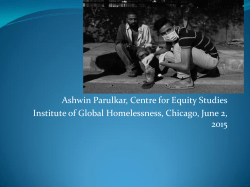
HERE - Calgary Homeless Foundation
WHO ARE THE HOMELESS? NUMBERS, TRENDS AND CHARACTERISTICS Ron Kneebone The School of Public Policy, University of Calgary Meaghan Bell Calgary Homeless Foundation Nicole Jackson Calgary Homeless Foundation Ali Jadidzadeh University of Calgary Thanks to the Calgary Drop-in and Rehab Centre Society for providing us with access to data and to Social Sciences and Humanities Research Council for funding. www.policyschool.ca POINT IN TIME COUNTS SINCE 1992 4,000 3,601 Number of Homeless 3,500 3,157 3,000 2,397 2,500 2,000 1,737 1,296 1,500 988 1,000 500 447 461 615 0 www.policyschool.ca 3,576 3,533 3,531 3,190 WHERE THE HOMELESS ARE FOUND 6% 6% Emergency shelter Short-term supportive housing 35% 54% Public Systems Rough Sleeping www.policyschool.ca ETHNICITY OF THE HOMELESS 5% 17% Caucasion Aboriginal Other 20% 59% www.policyschool.ca Unknown AGE OF THE HOMELESS 2% 4% 2% 7% 10% Children Youth Young adults Working age Seniors Unknown 75% www.policyschool.ca DATA Date 2009 2010 2011 2012 2013 2014 2009-14 Unique IDs 13,852 9,551 9,327 10,280 11,586 5,672 32,972 www.policyschool.ca PATTERNS OF SHELTER STAYS Few Episodes Many Episodes Short Stays per episode Transitional (86%) Episodic (12%) Long Stays per episode Chronic (1.6%) -- www.policyschool.ca SHELTER STAYS BY SHELTER USER www.policyschool.ca DEMOGRAPHICS OF SHELTER USERS Unique Clients Gender (%): Male Female Average Age Age Groups (%): Youth (16 - 19 years) Young adult (20 - 39 years) Middle age (40 - 59 years) Senior (60 years and more) Ethnicity (%): Caucasian Aboriginal Other Transitional 28,344 Episodic 4,097 Chronic 531 82.6 17.4 38.30 85.5 14.5 40.53 90.6 9.4 48.03 4.0 50.2 41.2 4.3 1.7 41.9 52.5 3.9 0.0 19.4 69.5 11.1 68.7 18.8 12.5 64.7 25.2 10.1 81.2 9.8 9.0 www.policyschool.ca IMPLICATIONS • The vast majority of adults using emergency shelters use them very infrequently and for only short stays • Establishing permanent, supportive housing for a relatively small number of people would free up 1/3 of all adult emergency shelter beds • Permanent supportive housing is expensive but so too is maintaining shelter beds and the increased costs to the health care and justice systems stemming from homelessness www.policyschool.ca EXAMPLES OF CURRENT EFFORTS • Coordinated Access and Assessment • Improves targeting of program interventions • RESOLVE • Collaborative partnership of 9 social agencies to raise $120 million to build affordable, supportive housing for 3,000 people • Calgary Homeless Foundation and RESOLVE • Raising $45 million to build 8 permanent supportive housing buildings (25 -30 units each) for chronically homeless • Joint effort of CHF, Government of Alberta and home builders www.policyschool.ca FUTURE EFFORTS • At the heart of Calgary’s homelessness problem is a lack of affordable housing • Solving that problem requires engaging the private sector; efforts that require consideration of • Tax incentives • Zoning changes • Housing regulations. www.policyschool.ca
© Copyright 2025





















